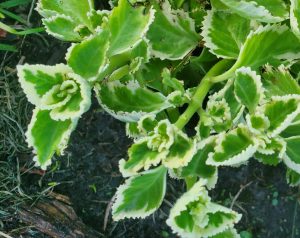
Dual purpose plants are a boon to landscapes where gardeners are looking for vegetation that provides both edible and ornamental features. A plant called Cuban oregano is one of those plants that checks both boxes. I first encountered the Cuban Oregano when I lived in the West Indies where it was called “Thick-Leaved Thyme”. Also called “Caribbean Oregano”, “County Borage”, “Indian Borage”, “French Thyme” “Indian Mint” “Mexican Mint”, “Soup Mint”, and “Spanish Thyme”, Cuban oregano is a wonderful plant suitable for our area. Have you seen the Cuban oregano or is it already in your garden?
Originally from Southern and Eastern Africa, this perennial plant, Cuban oregano is noted for its aromatic leaves. The large thick and velvety leaves are grey green in color, while the variegated cultivar is edged in white with an attractive blotchy lighter/darker green interior. There are even two noted named cultivars – ‘Cerveza ‘n Lime’ with silvery green leaves, and ‘Ochre Flame’ with attractive variegation and wavy-edged leaves. Growing upwards to nineteen inches tall and spreading much wider, the Cuban oregano grows rapidly and eventually produces stems of purplish flowers. I planted one rooted cutting of Cuban oregano and it easily filled in a five-by-five-foot patch of garden over one summer season. Not only does this plant make a good groundcover in your herb garden, but also is an excellent container plant when complemented with other herbs.
Grow Cuban oregano in well-drained soil in semi-shaded areas. This plant does not tolerate frost and will need protection during cold weather. Once established, this very succulent perennial plant will need to be watered only sparingly.
Use this herb according to your tastes and needs. The camphor and menthol scent can be overpowering if used in excess, so carefully flavor dishes with Cuban oregano. This herb can be used fresh or dry – use sparingly until you can gauge your taste for this strong herb. While you may find Cuban oregano at local garden centers, there are specimens available at almost every community plant sale, or just pick up a cutting or two from a gardening friend. Cuban oregano is a true pass-along plant that is easily propagated with tip cuttings to make new plants. Cuban oregano has certainly traveled the world based on its popularity and multiple uses.
One side note of concern is that while Cuban oregano is perfectly fine for humans, it is noted as being toxic by the ASPCA to dogs, cats, and horses – so be aware of this issue.
Try to have at least one Cuban oregano plant in your yard to look at, use in cooking, or simply brush by to release its refreshing fragrance! For more information on herbs suitable to grow in our area, or to ask a question, you can also call the Master Gardener Volunteer Helpdesk on Mondays, Wednesdays, and Fridays from 1 to 4 pm at 764-4340 for gardening help and insight into their role as an Extension volunteer. Ralph E. Mitchell is the Director/Horticulture Agent for UF/IFAS Extension Charlotte County. He can be reached at 941-764-4344 or ralph.mitchell@charlottecountyfl.gov. Connect with us on social media. Like us on Facebook @CharlotteCountyExtension and follow us on Instagram @ifascharco.
Resources:
Gardening Solutions (2018) Cuban Oregano. The University of Florida Extension Service, IFAS.
Jordi, R. (2006) Cuban oregano. The University of Florida Extension Service, IFAS.
Fact sheet: Cuban Oregano. (2017) The University of Florida Extension Service, IFAS – Nassau County.
North Carolina Extension Plant Toolbox (2024) Plectranthus amboinicus. https://plants.ces.ncsu.edu/plants/plectranthus-amboinicus/.
Wikipedia.com (2017) Plectranthus amboinicus.
ASPCA (2024) Indian Borage – https://www.aspca.org/pet-care/animal-poison-control/toxic-and-non-toxic-plants/indian-borage.
McAlpine, (2023) L. How to Plant, Grow, and Care for Cuban Oregano. Better Homes & Gardens.
 2
2
